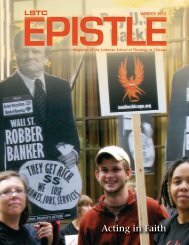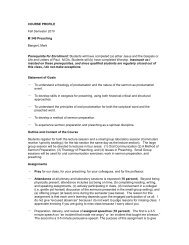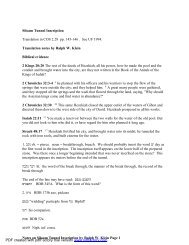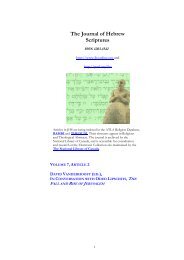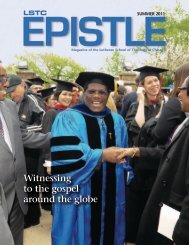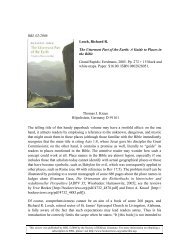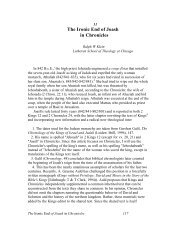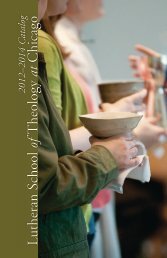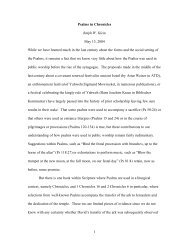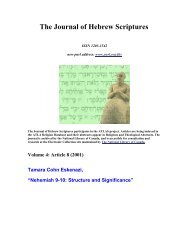6 Interested Partieslife; we would all like our fellow citizens to behave better, andwe know we would feel less envy and less fear if they wereall more like us. But if you are a little country being targetedfor annexation by a big one, as Israel was by Assyria, the highmindednessand moral sensitivity of the average citizen arenot going to make a lot of difference.In short, it would be uncritical of us to accept Amos’s analys<strong>is</strong>of h<strong>is</strong> society, to simply buy the ideology of the text. Somehowwe need to d<strong>is</strong>tance ourselves from the prophetic voice, andrecognize <strong>that</strong> the prophet’s <strong>is</strong> only one voice in h<strong>is</strong> community.The prophet, and the text, have a corner to fight, a position touphold, and we for our part need to identify <strong>that</strong> position, and torelativize it, not so as to d<strong>is</strong>card it but only so as to give it itsproper due. But, hardly surpr<strong>is</strong>ingly, most of the books aboutAmos simply take Amos’s point of view for granted. Amos <strong>is</strong>right, h<strong>is</strong> opponents are wrong; Amos <strong>is</strong> fair; Amos <strong>is</strong> accurate;Amos <strong>is</strong> immensely perceptive; Amos <strong>is</strong> inspired. 77 . Here <strong>is</strong> a striking example of commentators’ incapacity to d<strong>is</strong>tingu<strong>is</strong>hbetween the text and themselves. Andersen and Freedman (Amos,pp. 88-97) have a section on ‘The God of Israel in the Book of Amos’. Itopens by saying, ‘Our purpose <strong>is</strong> to present Amos’ picture of the deity, notours, and to keep it within the thought world of the ancient Near East andthe Bible rather than to translate it into contemporary theological or philosophicallanguage’ (p. 88). That sounds scholarly and objective enough. Butthe section concludes by saying: ‘What it finally comes down to <strong>is</strong> thenature of the God of the Bible, the person with whom the prophet mustdeal (and vice versa) and the person around whom everything turns. Whenall of the superlatives have been exhausted and when all of the authority ormajesty have been accorded and the recognition given to the one incomparabledeity who stands uniquely alone and against everything <strong>that</strong> <strong>is</strong> per<strong>is</strong>hable,vulnerable, corruptible, and the rest, he nevertheless remains a person.That <strong>is</strong> the fundamental and ultimate category in the Bible, as withoutit nothing else matters . . . Once it <strong>is</strong> agreed <strong>that</strong> th<strong>is</strong> God—creator and sustainerof heaven and earth, sole and unique—<strong>is</strong> the God of the Bible andIsrael and Amos and the rest of us, then we may draw closer and ask himwho he <strong>is</strong>, <strong>what</strong> he <strong>is</strong> like, and how things run in th<strong>is</strong> world’ (p. 97). By th<strong>is</strong>point, plainly, we readers are not reading any more about Amos and theancient world, for Amos had no Bible and thus no God of the Bible. Nor arewe reading about Amos’s God when we read <strong>that</strong> God <strong>is</strong> ‘against everything<strong>that</strong> <strong>is</strong> per<strong>is</strong>hable, vulnerable, corruptible’—for are those terms nottrue of humanity, and <strong>is</strong> Amos’s God ‘against’ humanity in general? And
4. <strong>Metacommentating</strong> Amos 7In order to pract<strong>is</strong>e metacommentary, we need to do someclose reading of commentaries. Here <strong>is</strong> my first exhibit:In eighth-century Israel the rich got richer and the poor gotpoorer . . . Amos sketches the well-being enjoyed by the upperclasses in the capital cities, the splendid society <strong>that</strong> was builtupon the m<strong>is</strong>ery of the weak and poor . . . Expensive furniture,indolent ease, succulent food, the sound of music, and extravagantindulgence—so the affluent in Samaria live. Every itemrepresents a luxurious soph<strong>is</strong>tication <strong>that</strong> had been possible inearlier times only for royalty, and remained a world apart fromthe life in the villages. The hollowness of it all only becomesapparent in 6c where th<strong>is</strong> heedless hedon<strong>is</strong>m <strong>is</strong> thrown into reliefagainst the ‘ruin of Joseph’ from which it <strong>is</strong> completelyinsulated. 8Such a rich text repays close reading.In eighth-century Israel the rich got richer and the poor got poorer. 9If it <strong>is</strong> true <strong>that</strong> the rich got richer, can we be sure <strong>that</strong> the poorgot poorer? The gap between rich and poor can widen evenwhile everyone’s standard of living <strong>is</strong> improving. What aboutthose who were neither rich nor poor (? the majority). And inany case, how can we possibly know whether the poverty portrayedin Amos was widespread; how can we know whether therich were in some way responsible for the poverty of the poor orwhether there was some structural cause, which was really noone individual’s fault, for the poverty of a minority?Amos sketches the well-being enjoyed by the upper classes in the capitalcities, the splendid society <strong>that</strong> was built upon the m<strong>is</strong>ery of the weakand poor. 10‘Splendid’ <strong>is</strong> ironic, <strong>is</strong> it not? It <strong>is</strong> not an objective scholarlydescription, <strong>is</strong> it? It <strong>is</strong> actually representing Amos’s (ironic) pointof view in the gu<strong>is</strong>e of a scholarly description, <strong>is</strong> it not? Andwhen, at the end, we start to read about <strong>what</strong> <strong>is</strong> ‘agreed’ and are told <strong>that</strong>‘we’ may ‘draw closer and ask him who he <strong>is</strong>’ (how?), we can feel sure <strong>that</strong>the authors’ trumpeted scholarly interests in the ancient world have beensubmerged by their own ideological beliefs.8 . Mays, Amos, pp. 114, 116.9 . Mays, Amos, p. 114.10 . Mays, Amos, p. 114.



